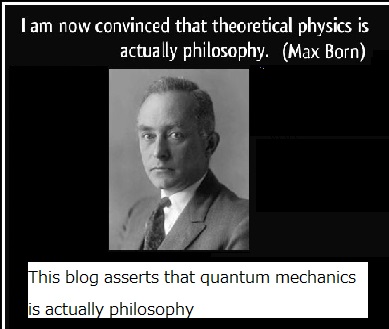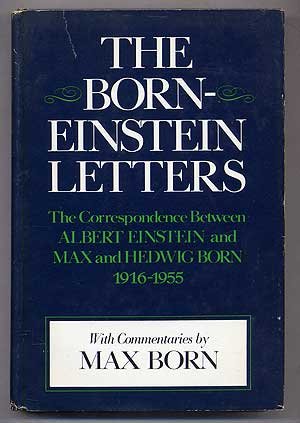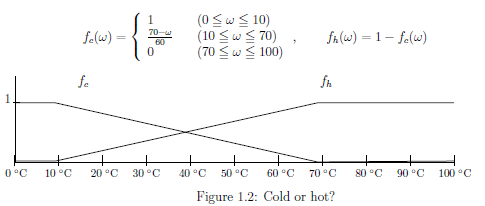Measurement theory (= quantum language ) is formulated as follows.
\[
\underset{\mbox{ (=quantum language)}}{\fbox{pure measurement theory (A)}}
:=
\underbrace{
\underset{\mbox{ (\(\S\)2.7)}}{
\overset{
[\mbox{ (pure) Axiom 1}]
}{\fbox{pure measurement}}
}
+
\underset{\mbox{ ( \(\S \)10.3)}}{
\overset{
[{\mbox{ Axiom 2}}]
}{\fbox{Causality}}
}
}_{\mbox{ a kind of incantation (a priori judgment)}}
+
\underbrace{
\underset{\mbox{
(\(\S\)3.1)
}}
{
\overset{
{}}{\fbox{Linguistic interpretation}}
}
}_{\mbox{ the manual on how to use spells}}
\]
Now we can explain Axiom 1
(measurement).
2.7.1 Axiom1(measurement)
With any system $S$, a basic structure $[ {\mathcal A} \subseteq \overline{\mathcal A} \subseteq {B(H)}]$ can be associated in which measurement theory of that system can be formulated. A state (or precisely, { pure state}) of the system$S$ is represented by an element of state space ${\frak S}^p({\mathcal A}^*)$.
An observable n(= measuring insrument ) is represented by a $C^*$-obvervable ${\mathsf O}$ ${{=}}$ $(X , {\cal F} , F{})$ in ${\mathcal A}$ ( or, $W^*$-obvervable ${\mathsf O}$ ${{=}}$ $(X , {\cal F} , F{})$ in $\overline{\mathcal A}$ ).
In a basic structure $[ {\mathcal A} \subseteq \overline{\mathcal A} \subseteq {B(H)}]$, consider a $W^*$-measurement ${\mathsf M}_{\overline{\mathcal A}} \big({\mathsf O}{{=}} (X, {\cal F} , F{}), S_{[{}\rho] } \big)$ $\Big($ or, $C^*$-measurement ${\mathsf M}_{{\mathcal A}} \big({\mathsf O}{{=}} (X, {\cal F} , F{}), S_{[{}\rho] } \big)$ $\Big)$.
$(A_1):$ An observer takes a measurement of an observable [${\mathsf O}$] for a state $\rho$, and gets a measured value $x (\in X )$.
Note that
$\bullet$ a $W^*$-measurement ${\mathsf M}_{\overline{\mathcal A}} \bigl({\mathsf O} , S_{[{}\rho{}] } \bigl)$ $\Big($ or, $C^*$-measurement ${\mathsf M}_{{\mathcal A}} \big({\mathsf O}{{=}} (X, {\cal F} , F{}), S_{[{}\rho] } \big)$ $\Big)$ of an observable ${\mathsf O}{{=}} (X, {\cal F} , F{})$ for a state $\rho(\in {\frak S}^p({\cal A}^*))$
In this lecture, we mainly devote ourselves to $W^*$-measurements.
$(A_2):$
$\left\{\begin{array}{ll}
\mbox{ $W^*$-measurement
${\mathsf M}_{\overline{\mathcal A}} \big({\mathsf O} , S_{[\rho]} \big)$}
&\cdots
\mbox{
${\mathsf O}$ is $W^*$- observable ,$\rho \in {\frak S}^p ({\mathcal A}^* )$
}
\\
\mbox{ $C^*$-measurement
${\mathsf M}_{{\mathcal A}} \big({\mathsf O} , S_{[\rho]} \big)$}
&\cdots
\mbox{
${\mathsf O}$ is $C^*$- observable ,$\rho \in {\frak S}^p ({\mathcal A}^* )$
}
\end{array}\right.
$


$
\underset{\mbox{(Japanese proverb)}}{\fbox{ even monkeys fall from trees}}
$
$\Large{\mbox{Monkey changes to }} \left\{\begin{array}{ll} \Large{\mbox{Homer}} \\ \small{\mbox{(Homer sometimes nods)}} \\ \\ \Large{\mbox{horse}} \\ \small{\mbox{( It is a good horse that never stumbles.)}} \\ \\ \cdots \end{array}\right\} \mbox{} $
 Axiom 1(measurement) pure type${\mathsf M}_{\overline{\mathcal A}} \big({\mathsf O}{{}},
S_{[{}\rho] }\big)$
Axiom 1(measurement) pure type${\mathsf M}_{\overline{\mathcal A}} \big({\mathsf O}{{}},
S_{[{}\rho] }\big)$
| $\bullet$ | $\;\;$ a $W^*$-measurement ${\mathsf M}_{\overline{\mathcal A}} \bigl({\mathsf O} , S_{[{}\rho{}] } \bigl)$ $\Big($ or, $C^*$-measurement ${\mathsf M}_{{\mathcal A}} \big({\mathsf O}{{=}} (X, {\cal F} , F{}), S_{[{}\rho] } \big)$ $\Big)$ of an observable ${\mathsf O}{{=}} (X, {\cal F} , F{})$ for a state $\rho(\in {\frak S}^p({\cal A}^*):\mbox{state})$ |
Then, the probability that a measured value $x$ $( \in X )$ obtained by the $W^*$-measurement ${\mathsf M}_{\overline{\mathcal A}} \bigl({\mathsf O} , S_{[{}\rho{}] } \bigl)$ $\Big($ or, {$C^*$-measurement} ${\mathsf M}_{{\mathcal A}} \big({\mathsf O}{{=}} (X, {\cal F} , F{}), S_{[{}\rho] } \big)$ $\Big)$ belongs to $ \Xi $ $(\in {\cal F}{})$ is given by \begin{align*} \rho( F(\Xi)) (\equiv {}_{{{\mathcal A}^*}}(\rho, F(\Xi) )_{\overline{\mathcal A}} ) \end{align*} (if $F(\Xi)$ is essentially continuous at $\rho$, or see (2.56) in Definition 2.19 ).

| $\fbox{Note 2.4}$ | [The Bohr?Einstein debates].
The above axiom is due to Max Born (1926).
There are many opinions for the term "probability".
For example, Einstein sent Born the following letter (1926):
|
Now we shall describe Example1.2 ( Cold or hot?) in terms of quantum language (i.e.,Axiom 1).
Example 2.31[(continued from Example1.2) The measurement of "cold or hot" for water in a cup ]
Consider the classical basic structure: \begin{align*} \mbox{ $[C_0(\Omega ) \subseteq L^\infty (\Omega, \nu ) \subseteq B(L^2 (\Omega, \nu ))]$ } \end{align*}
Here, $\Omega=$ the closed interval $[0,100](\subset {\mathbb R})$ with Lebesgue measure $\nu$. The state space ${\frak S}^p(C_0(\Omega)^*)$ is characterized as
\begin{align*} {\frak S}^p(C_0(\Omega)^*)=\{ \delta_\omega \in {\mathcal M}(\Omega) \;|\; \omega \in \Omega \} \approx \Omega =[0,100] \end{align*}
In Example 1.2, we consider this [C-H]-thermometer ${\mathsf O} =$ $(f_{{c}},f_{{h}})$, where the state space $\Omega=[0,100]$, the measured value space $X=\{ {c,h}\}$. That is,
| $(\sharp)$: | $ \qquad \qquad f_{c} (\omega) = \left\{\begin{array}{ll} 1 & \quad (0 {{\; \leqq \;}}\omega {{\; \leqq \;}}10 ) \\ \frac{70- \omega}{60} & \quad (10 {{\; \leqq \;}}\omega {{\; \leqq \;}}70 ) \\ 0 & \quad (70 {{\; \leqq \;}}\omega {{\; \leqq \;}}100 ) \end{array}\right., \qquad f_{h} (\omega) = 1- f_{c} (\omega) $ |
Then, we have the (cold-hot) observable ${\mathsf O}_{ch}= (X , 2^X, F_{ch} )$ in $L^\infty ( \Omega )$ such that
\begin{align*} & [F_{ch}(\emptyset )](\omega ) = 0, \quad &{}& [F_{ch}(X )](\omega ) = 1 \\ & [F_{ch}(\{c\})](\omega ) = f_{c} (\omega ), &{}& [F_{ch}(\{h\})](\omega ) = f_{h} (\omega ) \end{align*}Thus, we get a measurement ${\mathsf M}_{L^\infty ( \Omega )} ( {\mathsf O}_{ch}, S_{[\delta_\omega]} )$ $($ or in short, ${\mathsf M}_{L^\infty ( \Omega )} ( {\mathsf O}_{ch}, S_{[{\omega}]} )$. Therefore, for example, putting $\omega=55$°C, we can, by Axiom 1 ($\S$2.7), represent the statement (A$_1$) in Example 1.2 as follows.
| (a): | the probability that a measured value$x(\in X {{=}} \{c, h\})$ obtained by measurement $\left.\begin{array}{ll}{\mathsf M}_{L^\infty ( \Omega )} ( {\mathsf O}_{ch}, S_{[ \omega(=55)]} ) \end{array}\right.$ belongs to set $ \left[\begin{array}{ll} {} \emptyset \\ \{ \mbox{c}\} \\ \{ {h} \} \\ \{ {c} ,{h}\} \end{array}\right] $ is given by $ \left[\begin{array}{ll} {} [F_{ch}( \emptyset )](55)= 0 \\ {} [F_{ch}( \{ { c} \} )](55)= 0.25 \\ {} [F_{ch}( \{ { h} \} )](55)= 0.75 \\ {} [F_{ch}( \{ { c} , { h} \} )](55)= 1 \end{array}\right] $ |
